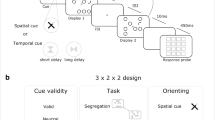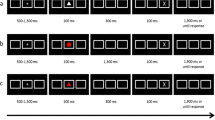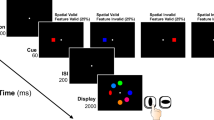Abstract
Visual cues that allow predicting location and onset of a stimulus facilitate orienting. In a seminal study, Coull and Nobre (J Neurosci 18:7426–7435, 1998) adapted the spatial cueing paradigm to investigate temporal orienting. Recent research in the spatial domain suggests though that the cues used in the spatial and temporal conditions were not comparable. In the spatial condition predictive arrow cues engaged involuntary and voluntary attention, in the temporal condition line width cues elicited voluntary attention shifts. A valid comparison between attentional modalities on the behavioural and neurophysiological level requires though that cues differ only with respect to attentional modality (spatial, temporal) and not in other aspects. To develop cues that are comparable and to assess spatial and temporal orienting, new line width cues for spatial and temporal orienting were devised that both engage only voluntary attention, and the results were compared to the cues used by Coull and Nobre (J Neurosci 18:7426–7435, 1998). Further, catch trials were included to counteract reorienting at the late time interval to promote comparisons between spatial and temporal data at that interval. The results showed that the outcome of the comparison between spatial, temporal and spatiotemporal orienting depended on the type of cue that was used and hence the type of attention that was engaged in each condition. The results indicated that orienting is equally effective in space and in time when attention is directed voluntarily. The new cues employed here can easily be used for future studies to assess underlying brain mechanisms.



Similar content being viewed by others
Notes
The use of the term “involuntary” is not supposed to imply that orienting to arrows is impenetrable to top-down control or that the same mechanisms that underlie cueing effects elicited by abrupt onsets underlie also effects of arrow cues.
The results were confirmed by additional analyses for which potential outliers (RT > 2.5 SD above the mean per participant per condition; 1.7 %) were removed.
Prior to the experiment it was assessed whether performance is comparable for both types of cues regarding extracting spatial and temporal information. Participants of that pilot study were presented with CN and LW cues and asked to indicate by button press the meaning of the cues (e.g., left-early). They were as accurate for LW as for CN cues, p = .662, and were equally efficient to respond to both types of cues, p = .148.
The results were confirmed by additional analyses for which potential outliers (RT > 2.5 SD above the mean per participant per condition; 1.9 %) were removed.
It appears as if participants were faster on valid trials in Experiment 2 than 1 but this difference was not significant, p > .05.
Differential effects on disengaging of attention for involuntary and voluntary orienting are also supported by the finding that patients with spatial neglect do only show disengage deficits when cues involve involuntary orienting, and not when cues engage only voluntary orienting (Olk et al. 2010).
References
Abegg M, Manoach DS, Barton JJS (2011) Knowing the future: partial foreknowledge effects on the programming of prosaccades and antisaccades. Vis Res 51:215–221
Bartolomeo P, Siéroff E, Decaix C, Chokron S (2001) Modulating the attentional bias in unilateral neglect: the effects of the strategic set. Exp Brain Res 137:432–444
Botta F, Lupianez J, Chica AB (2014) When endogenous spatial attention improves conscious perception: effects of alerting and bottom-up activation. Conscious Cognit 23:63–73
Brignani D, Guzzon D, Marzi CA, Miniussi C (2009) Attentional orienting induced by arrows and eye-gaze compared with an endogenous cue. Neuropsychologia 47:370–381
Capizzi M, Sanabria D, Correa A (2012) Dissociating controlled from automatic processing in temporal preparation. Cognition 123:293–302
Castel AD, Chasteen AL, Scialfa CT, Pratt J (2003) Adult age differences in the time course of inhibition of return. J Gerontol B Psychol Sci 58B:256–259
Correa A (2010) Enhancing behavioural performance by visual temporal orienting. In: Nobre AC, Coull JT (eds) Attention and time. Oxford University Press, New York, pp 359–370
Correa A, Lupiáñez J, Milliken B, Tudela P (2004) Endogenous temporal orienting of attention in detection and discrimination tasks. Percept Psychophys 66:264–278
Correa A, Lupiáñez J, Tudela P (2006) The attentional mechanism of temporal orienting: determinants and attributes. Exp Brain Res 169:58–68
Coull JT (2010) Neural substrates of temporal attentional orienting. In: Nobre AC, Coull JT (eds) Attention and time. Oxford University Press, New York, pp 429–442
Coull JT, Nobre AC (1998) Where and when to pay attention: the neural systems for directing attention to spatial locations and to time intervals as revealed by both PET and fMRI. J Neurosci 18:7426–7435
Davranche K, Nazarian B, Vidal F, Coull J (2011) Orienting attention in time activates left intraparietal sulcus for both perceptual and motor task goals. J Cogn Neurosci 11:3318–3330
Dodd MD, Wilson D (2009) Training attention: interactions between central cues and reflexive attention. Vis Cognit 17:736–754
Doherty JR, Rao A, Mesulam MM, Nobre AC (2005) Synergistic effect of combined temporal and spatial expectations on visual attention. J Neurosci 25:8259–8266
Friesen CK, Kingstone A (1998) The eyes have it! Reflexive orienting is triggered by nonpredictive gaze. Psychon Bull Rev 5:490–495
Frischen A, Smilek D, Eastwood JD, Tipper SP (2007) Inhibition of return in response to gaze cues: the roles of time course and fixation cue. Vis Cognit 15:881–895
Gibson BS, Bryant TA (2005) Variation in cue duration reveals top-down modulation of involuntary orienting to uninformative symbolic cues. Percept Psychophys 67:749–758
Griffin I, Miniussi C, Nobre AC (2002) Multiple mechanisms of selective attention: differential modulation of stimulus processing by attention to space or time. Neuropsychologia 40:2325–2340
Hommel B, Pratt J, Colzato L, Godijn R (2001) Symbolic control of visual attention. Psychol Sci 12:360–365
Kingstone A (1992) Combining expectancies. Q J Exp Psychol 44A:69–104
Klein RM (1994) Perceptual-motor expectancies interact with covert visual orienting under endogenous but not exogenous control. Can J Exp Psychol 48:151–166
Lange K (2013) The ups and downs of temporal orienting: a review of auditory temporal orienting studies and a model associating the heterogeneous findings on the auditory N1 with opposite effects of attention and prediction. Front Hum Neurosci 7:263
Langley LK, Friesen CK, Saville AL, Ciernia AT (2011) Timing of reflexive visuospatial orienting in young, young-old, and old-old adults. Atten Percept Psychophys 73:1546–1561
Li CL, Chen KW, Han HB, Chui DH, Wu JL (2012) An fMRI study of the neural systems involved in visually cued auditory top-down spatial and temporal attention. PLoS One 7:e49948
MacKay A, Juola JF (2007) Are spatial and temporal attention independent? Percept Psychophys 69:972–979
Näätänen R (1972) Time uncertainty and occurrence uncertainty of the stimulus in a simple reaction time task. Acta Psychol 36:492–503
Olk B, Cameron B, Kingstone A (2008) Enhanced orienting effects: evidence for an interaction principle. Vis Cognit 16:979–1000
Olk B, Hildebrandt H, Kingstone A (2010) Involuntary but not voluntary orienting contributes to a disengage deficit in visual neglect. Cortex 46:1149–1164
Olk B, Tsankova E, Petca AR, Wilhelm AFX (2014) Measuring effects of voluntary attention: a comparison among predictive arrow, colour and number cues. Q J Exp Psychol. doi:10.1080/17470218.2014.898670
Posner MI (1980) Orienting of attention. Q J Exp Psychol 32:3–25
Ristic J, Kingstone A (2006) Attention to arrows. Pointing to a new direction. Q J Exp Psychol 59:1921–1930
Ristic J, Kingstone A (2012) A new form of human spatial attention: automated symbolic orienting. Vis Cognit 20:244–264
Rohenkohl G, Coull JT, Nobre AC (2011) Behavioural dissociation between exogenous and endogenous temporal orienting of attention. PLoS One 6(1):e14620
Taylor TL, Klein RM (2000) Visual and motor effects in inhibition of return. J Exp Psychol Hum Percept Perform 26:1639–1656
Weger UW, Abrams RA, Law MB, Pratt J (2008) Attending to objects: endogenous cues can produce inhibition of return. Vis Cognit 16:659–674
Acknowledgments
I would like to thank Lieze Boshoff for bringing the paper by Coull and Nobre (1998) to my attention and Patience Mushamiri and Sofia Schlamp for support with data collection.
Author information
Authors and Affiliations
Corresponding author
Rights and permissions
About this article
Cite this article
Olk, B. Effects of spatial, temporal and spatiotemporal cueing are alike when attention is directed voluntarily. Exp Brain Res 232, 3623–3633 (2014). https://doi.org/10.1007/s00221-014-4033-7
Received:
Accepted:
Published:
Issue Date:
DOI: https://doi.org/10.1007/s00221-014-4033-7




